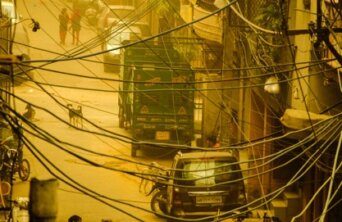- About
- Topics
- Picks
- Audio
- Story
- In-Depth
- Opinion
- News
- Donate
- Signup for our newsletterOur Editors' Best Picks.Send
Read, Debate: Engage.
| topic: | Air Pollution |
|---|---|
| located: | India |
| editor: | Hanan Zaffar |
As winter approaches, India’s capital, considered one of the most polluted cities in the world, is preparing for its annual battle with a silent but lethal foe: air pollution. New Delhi has risen to the top of the Swiss group IQAir’s list of the world's most polluted cities in real-time.
The air quality in Delhi has been worsening, with an Air Quality Index (AQI) of an average of 439, which falls under the “hazardous” category according to The Central Pollution Control Board. An AQI between zero and 50 is considered 'good', 51 and 100 'satisfactory', 101 and 200 'moderate', 201 and 300 'poor', 301 and 400 'very poor', and 401 and 500 'severe'.
Furthermore, the current PM2.5 - inhalable particulate matter - concentration in New Delhi is 25.4 times abovethe recommended limit given by the WHO 24-hour air quality guidelines value.
During this time of the year, severe air pollution has become a norm. The primary cause for this is the burning of stubble that takes place during this season. Due to an absence of viable alternatives, farmers in neighbouring regions burn the residue of their harvested crops, which results in an almost unbearable level of pollution in the air. Additionally, the constant emission of pollutants from vehicles and industries only exacerbates the situation.
The state prohibited non-essential building work and closed primary schools in the capital last evening in response to the level of air pollution. Because of the issue, diesel and gasoline cars operating in and around Delhi have been restricted, too. Government officials have also warned pollution levels in Delhi-NCR may deteriorate over the next month due to increased farm fires and a dip in temperature and air speed.
Numerous reports which call Delhi the world's most polluted city have suggested that citizens potentially lose a considerable amount of their lifespan due to pollution. The Air Quality Life Index (AQLI) study, conducted by the Energy Policy Institute at the University of Chicago, which was published in August 2023, notes the entirety of the 1.3 billion-strong Indian population lives in locations with yearly average particle pollution levels exceeding the WHO standard of 5 g/m3.
In the short term, exposure to high levels of pollutants can cause irritation in the eyes, nose, throat, and skin, coughing, breathing difficulties, wheezing, chest discomfort, and headaches. Vulnerable populations, such as small children and the elderly, may have more severe consequences, such as lower respiratory tract irritation and infections, worsening of asthma, bronchitis, or exacerbation of chronic conditions.
Owing to such an extreme pollution scenario, urgent effort is essential to reduce air pollution in Delhi. The authorities act only when the air quality deteriorates, while substantial and long-term actions are invisible. This is evident from the recurring deterioration of air around this time of the year. As is done every year, the authorities have implemented measures such as the odd-even traffic rule, which allows odd and even numbered vehicles to be on the roads alternatively.
Where the authorities appear unable to curb the menace of polluted air, certain independent groups are coming forward to lend a helping hand. One such group, the Air Pollution Action Group (A-PAG), works with the authorities to assist their implementation efforts in fighting air pollution. One of their flagship programmes is the Dispersed Sources of Pollution programme (DSP), which addresses dispersed sources of air pollution like dust and garbage. However, today, such efforts still prove too little to alleviate the humongous pollution levels triggered by industrial and agricultural sources.
Image by Bibhu Behera.

